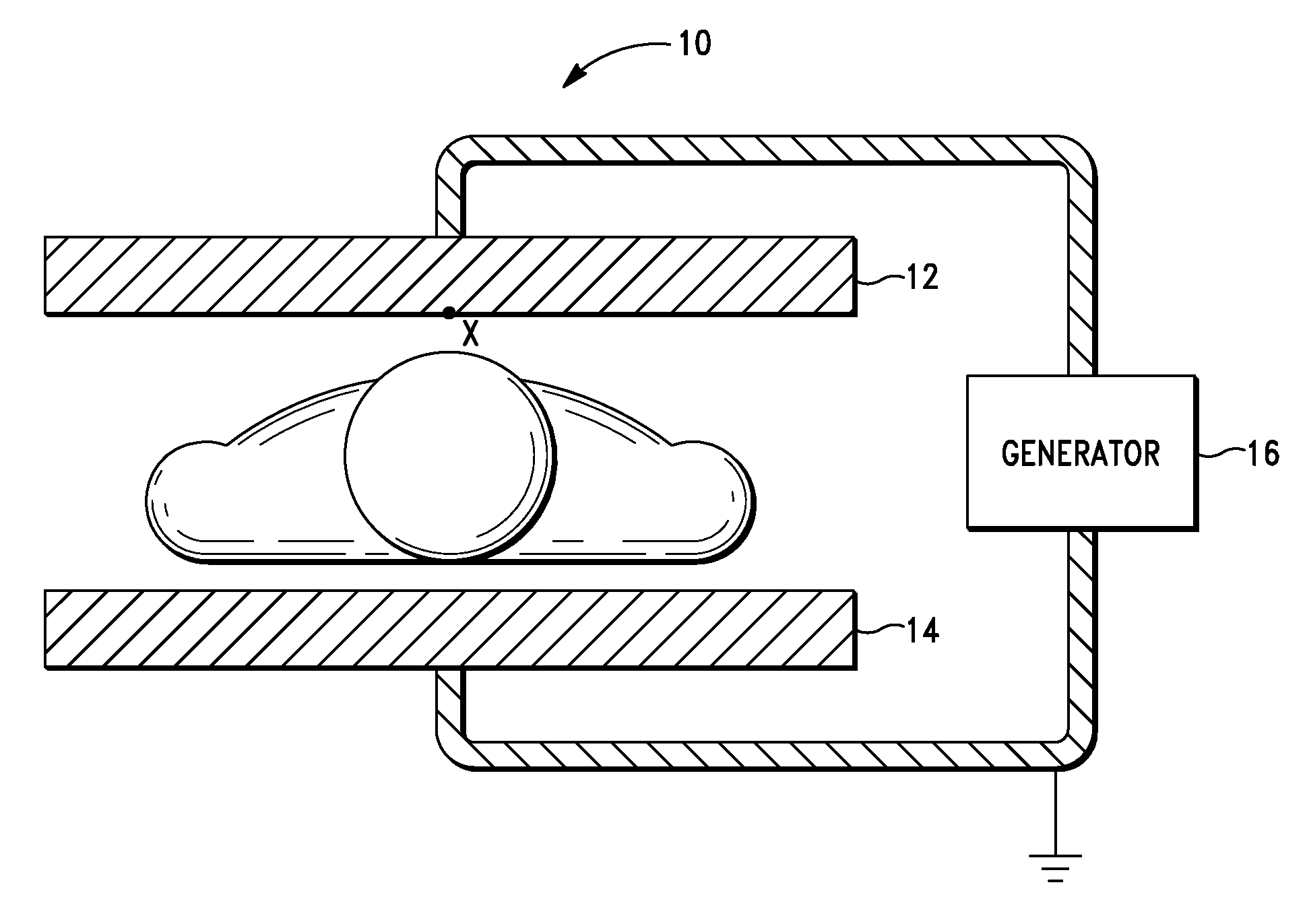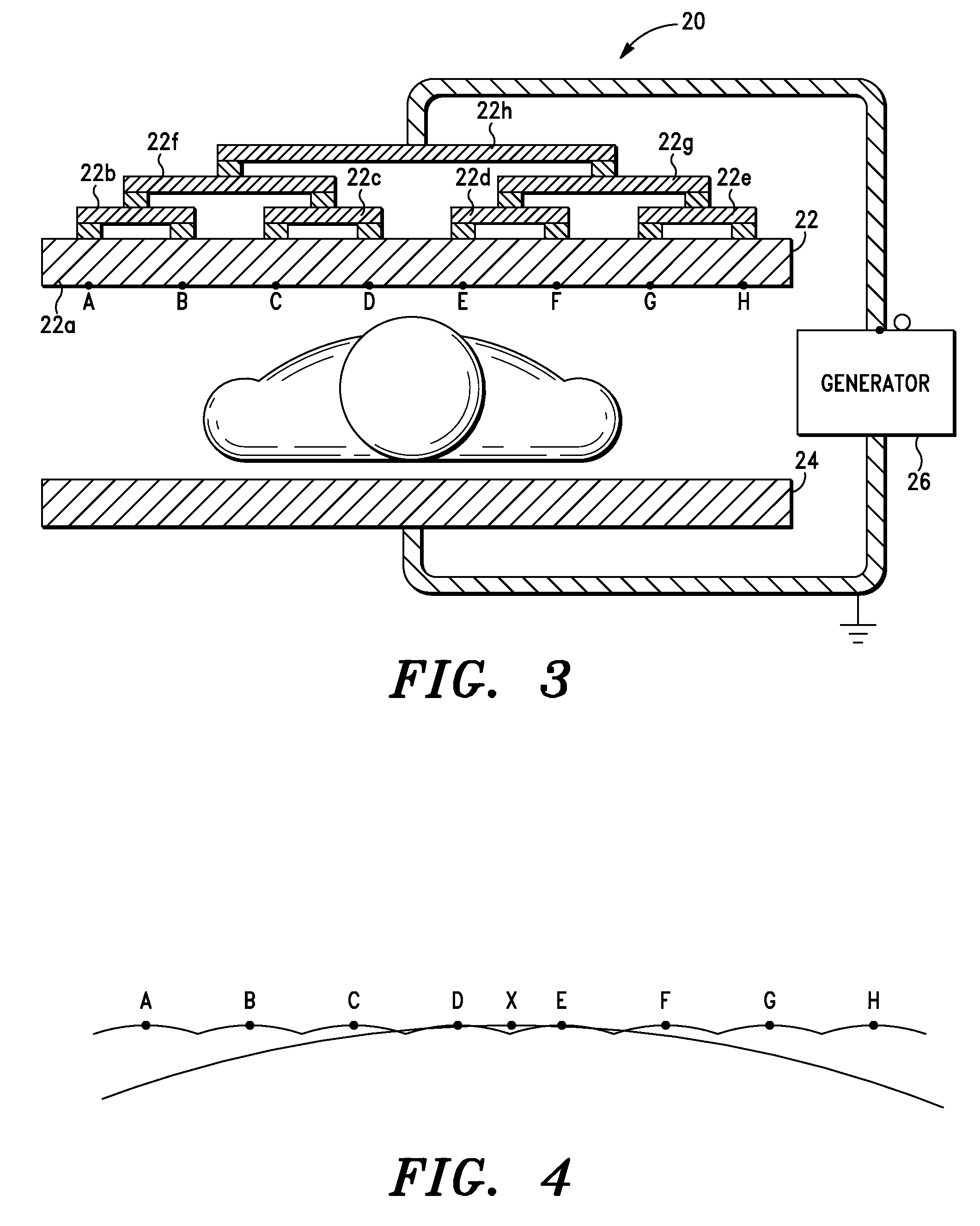Apparatus and Method for Heating Biological Targets
a biological target and apparatus technology, applied in the field of apparatus and methods for heating biological targets, can solve problems such as inability to achieve desired therapeutic outcomes, and achieve the effect of faster ra
- Summary
- Abstract
- Description
- Claims
- Application Information
AI Technical Summary
Benefits of technology
Problems solved by technology
Method used
Image
Examples
example 1
[0121]An example using this general methodology is provided below in which a human body is placed in apparatus 40 shown in FIG. 6a, wherein the treatment region includes the chest and shoulder regions of the body. The chest region has a thickness of 8 inches and the shoulder region has a thickness of 4 inches. In this example, it is assumed that the chest and shoulder regions of the body are substantially fat-free. The top and bottom electrodes 42 and 44 are spaced 8 inches apart, and the voltage between the electrodes is 1,000 volts. A flowable material comprising distilled water mixed with acetic acid (in volumes to be calculated below) is injected into top bladder 48 and bottom bladder 50. Accordingly, the material between the electrodes in the chest region is the human body (i.e., the 8 inch chest region abuts against both electrodes) and the material between the electrodes in the shoulder region is the human body and the distilled water / acetic acid mixture (i.e., the 4 inch sho...
example 2
[0355]An example using this general methodology is provided below in which a human body is placed in apparatus60 shown in FIG. 7a, wherein the treatment region includes the chest and stomach regions of the body. The chest region (which is substantially fat-free) has a thickness of 8 inches, and the stomach region has a thickness of 6⅜ inches, which includes 6 inches of non-fatty tissue and ⅜ inches of fat. For the sake of clarity, the 6 inches of non-fatty tissue (e.g., epidermal / dermal skin cells, stomach cells, circulatory cells, etc) in the stomach region will be referred to hereinafter as the “stomach region,” and the ⅜ inches of fat (e.g., adipose tissue) will be referred to hereinafter as the “stomach fat.”
[0356]The top and bottom electrodes 62 and 44 are spaced 8 inches apart, and the voltage between the electrodes is 1,000 volts. The compartments of top bladder 68 located adjacent the chest region (i.e., the row of compartments labeled 68d) are empty because the thickness of...
example 3
[0494]An example using this general methodology is provided below in which a human body is placed in apparatus 60 shown in FIG. 7a, wherein the treatment region includes the chest and stomach regions of the body. The chest region (which is substantially fat-free) has a thickness of 8 inches, and the stomach region has a thickness of 8 inches, which includes 7 inches of non-fatty tissue and 1 inch of fat. For the sake of clarity, the 7 inches of non-fatty tissue (e.g., epidermal / dermal skin cells, stomach cells, circulatory cells, etc) in the stomach region will be referred to hereinafter as the “stomach region,” and the 1 inch of fat (e.g., adipose tissue) will be referred to hereinafter as the “stomach fat.”
[0495]Acetic acid is injected into the compartments of top bladder 68 adjacent the chest region (e.g., the row of compartments labeled 68d) and into bottom bladder 70. Then, the compartments of top bladder 68 adjacent the stomach region / stomach fat (e.g., the two rows of compart...
PUM
 Login to View More
Login to View More Abstract
Description
Claims
Application Information
 Login to View More
Login to View More - R&D
- Intellectual Property
- Life Sciences
- Materials
- Tech Scout
- Unparalleled Data Quality
- Higher Quality Content
- 60% Fewer Hallucinations
Browse by: Latest US Patents, China's latest patents, Technical Efficacy Thesaurus, Application Domain, Technology Topic, Popular Technical Reports.
© 2025 PatSnap. All rights reserved.Legal|Privacy policy|Modern Slavery Act Transparency Statement|Sitemap|About US| Contact US: help@patsnap.com



